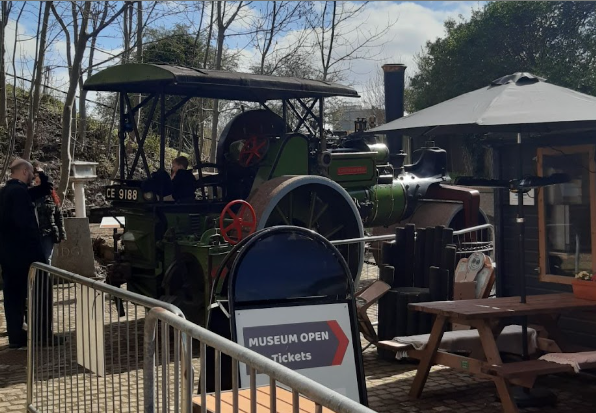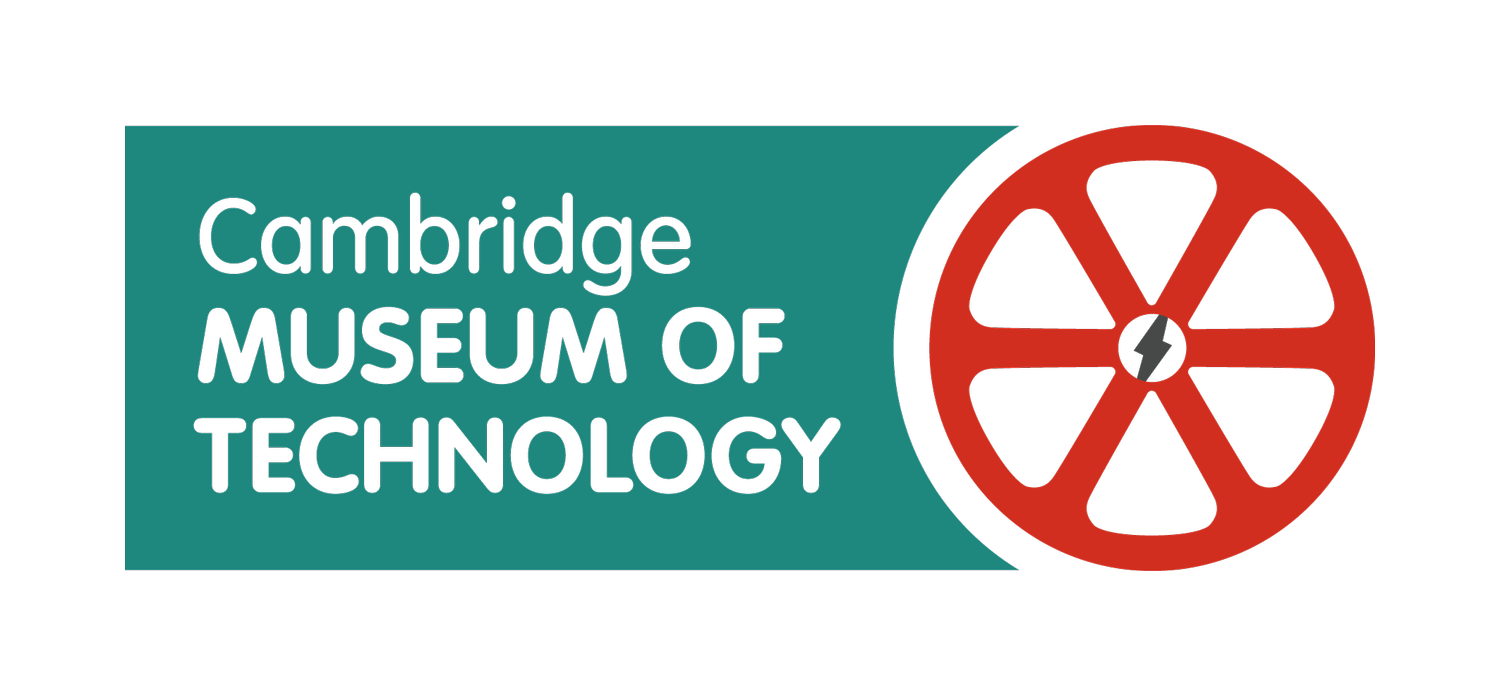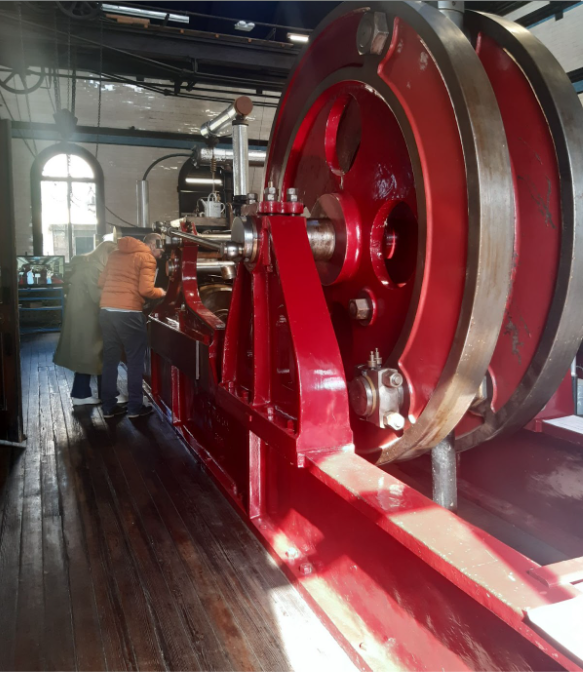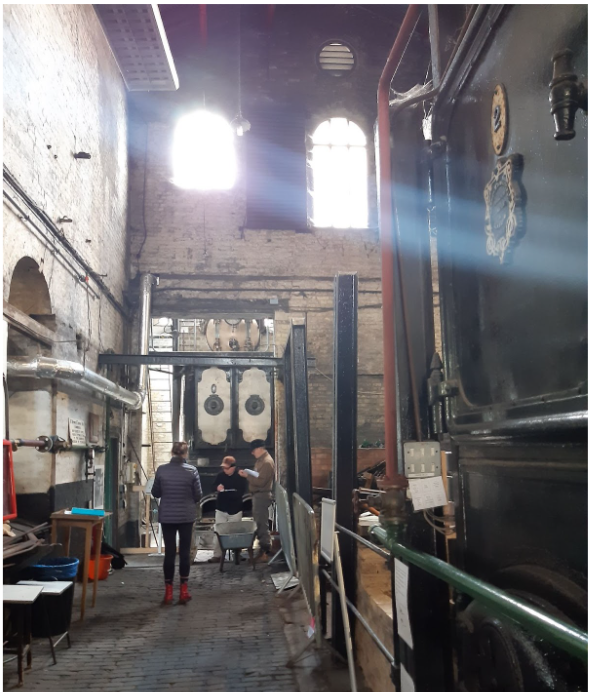Victoria-Anne Michel, a PhD researcher at Anglia-Ruskin University with OdEuropa project, explores how the smells of Cambridge Museum of Technology create multi-sensory environments for visitors to explore the city’s industrial heritage…with their noses!
Arrival
My first glimpse of the Museum (in April 2023) is its chimney, peeking out from behind the storefront. The contrast of the landscape brings a smile to my face and makes me stop for a few seconds to appreciate my senses.
Museum Front-of-House Leader Joanne Hamilton welcomes me to the Museum and introduces museum volunteers, who explain the history of the place and how the Museum works.
On a Friday, only the strollers and joggers occupy the space, but on the Saturday [1 April 2023] the Steam weekend starts. Tempestuous are the moods of each machine: they can be capricious and you can never be sure that they will turn and spit out their precious steam at the right moment.


scentS, Steam (AND COFFEE!)
Walking along the river Cam with its ducks and rowers, the water makes big puddles and gives the olfactory atmosphere a wet and slightly muddy note. It's a cool day, and even before having a coffee, I venture out on my first (small) smellwalk alone in order to discover the place by nose and by myself before guiding others by the tip of their noses. My senses are alert and I absorb as much the gleaming colours of the shiny machines and the tiled walls as the dull sound of footsteps against the old wooden floor contrasting with the deep exhales of the machines. It feels lukewarm then icy, it smells of soot, coal then dry paper and linoleum-like plastic, not to mention the fleeting but impactful scent of gourmet cinnamon as I pass by the coffee container.
SIX STAGES OF The SENSORY Tour ROUTE
This first tour on my own allows me to discover the Museum, to meet the people who take care of it and to decide on the route to take for all the next smellwalks that I will lead with the participants who have signed up and those I will recruit on the spot.
I decide to choose six spaces that I believe are characteristic of the history and diversity of the place. The smellwalk will begin in the courtyard where the café is located and will start in the machine room. This spectacular first stop, between the old wood floor, the cold tiles on the walls and the whirring machines in the centre, impacts the participants and awakens all their senses.
At the second stop, the semi-open room next door allows us to explore a sunken machine which treated waste-water and which still embodies an impression of depth, of low, dark and humid smells, mixed with the greasy and black smell of diesel/coal.
Changing PLACES, CHANGING Smells
This first olfactory patchwork is followed by a stop in the corridor extending the fireplaces of the high chimney, which is characteristic of the factory/museum and can be seen from miles around. Here, sight, touch and smell vibrate in unison to the rhythm of the black soot. It smells like coal, it sticks to the fingers, it is sandy and slightly greasy, it is all a palette of blacks and greys. The colour is brought out by the orange shades of the fire fuelled by the large pebbles of eco-coal that three volunteers take turns shovelling.
On the Sunday it will smell like cold bacon and raw red onion as the volunteers in blue overalls cook their food directly on the coals of the industrial chimney, certainly replicating the gestures and practices of the old workers.
CHANGING PERSPECTIVES THROUGH SMELL
After inhaling the smells of black coal and heavy dust, our research group makes our way to the fourth stop by stepping out into the courtyard for a moment, passing by the café, and then walking down the corridor of the coal-fired ovens in the Ash Tunnel, which are now out of use. Only the ochre-coloured lights and detailed signs indicate their former use.
This corridor brings the freshness of the stone and the smell of lighter dust and leads to the outer foot of the monumental chimney. If you tilt your head 160 degrees upwards, you squint and feel very small.
THE SMELL OF PRINT
The fourth stop is an assault on the nostrils: the Print Room. exhales the smell of dry ink and old paper. These smells are both contrasting in nature but echo the black and greasy smells of the previous stops. As cousins, they become more intense and more attached to the objects. One can put one's nose to the old bronze lettering, the ink-soaked stamps and the thick paper posters. It is an enveloping olfactory atmosphere, some would say stifling and quickly get out, both comforting and oppressive. The cramped space contributes to this double impression of intimacy and (constraint).
TOP BAY
When you finally come out, you take the stairs to the dark wooden building named Top Bay.. The pretty pistachio-green machine with its Ottoman-style glass and metal vials filled with honey-yellow lubricant and its little plastic duck spins and sets the pace/rhythm of the place, like a big clock that beats not time but space. Or is it the same thing?
Here, the wooden shed houses several smaller machines that the visitors can operate with a button. The smell of coal and dust is less intense, as is the smell of smoke.
PYE BUILDING
Finally, the sixth and last stop is like the last of a sibling group: it has a vague air of kinship with the previous ones but still has its own style. It is in the Pye building that the objects of the Pye company's radio station are displayed, mostly behind glass walls. One can smell the paint above all, a striking smell of plastic in the background. The colours are bright; the hum of the occasional triggered radio spits from a caramel-coloured wooden device but all these objects remain mostly silent.
REFLECTIONS ON A SMELLWALK
The experience was rich with learnings: I remember the good humour of the volunteers, the machines and the coffee, giving the Museum’s sensory atmosphere a coherence of subtle contrast. The greasy, dark smells seem to be the backdrop, which the colourful touches of sweets, plastic, bacon and sweat seem to enhance at times.
I wish for more! More industrial passion and more respect for these elegant old machines. More attention to the smells of industrial heritage, and more support for the enthusiasts who allow it to exist in our memories and in our senses.
COLLABORATE WITH THE MUSEUM
Do you have a project with which you would like to collaborate with Cambridge Museum of Technology? The Museum collaborates with both:
STEM (Science, Technology, Engineering and Mathematics): from engines to electronics
Arts: artists, sculptors, writers and performers
Contact the Museum through our website or social-media to explore how the Museum can host your event or research:





